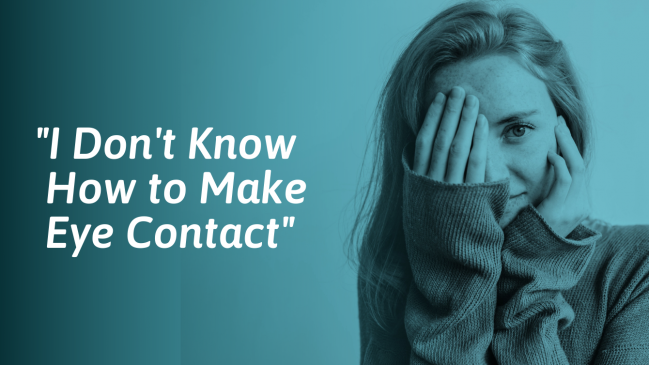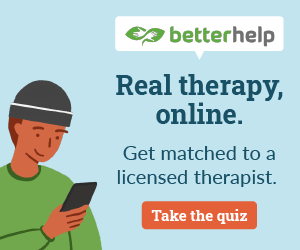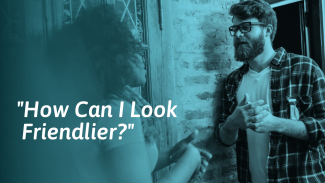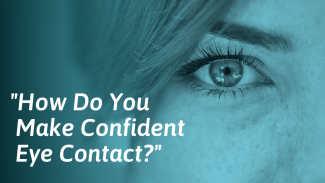“I want to show people I am interested during a conversation without making them uncomfortable. How do I maintain eye contact with someone I’m talking to without being creepy or awkward?”
Eye contact is one of the most important aspects of nonverbal communication, but one that many people struggle with. How do you make eye contact without staring? How much eye contact is too much? How can you show someone you’re listening without making them feel uncomfortable?
This article will answer these questions and provide tips on how to make eye contact in a way that feels natural and comfortable.
Sections
- Why eye contact is important
- How to make eye contact naturally
- Knowing when to make eye contact in specific situations
- Common questions
Why eye contact is important
Nonverbal cues like your facial expressions, eye contact, and body language have 65%-93% more of an impact than your words.[1] Not making eye contact, making too much eye contact, and even blinking too much can all work to either emphasize, confuse, or even discredit what you are saying.[2][3]
Appropriate amounts of eye contact can help in the following ways:[4][5]
- Lets people know you are listening to them
- Shows interest in what someone is saying
- Demonstrates respect and attentiveness to a speaker
- Adds credibility to what you are saying
- Helps to foster trust and closeness with someone
- Opens lines of communication
- Signals turn-taking in a conversation
- Can help to start or end a conversation
- Helps to get and hold people’s attention when speaking
While eye contact is essential, overusing it or misusing it can send the wrong message and even make people feel uncomfortable or offended. Below are 10 strategies to make and keep eye contact in a way that is natural and appropriate.
How to make eye contact naturally
1. Position yourself comfortably
In order to make eye contact easier and more natural, work on positioning yourself in a way that allows you to easily look at and talk to the person you are interacting with.
For example, sit across the table from a friend at lunch instead of beside them, or choose a seat on the inside of a circle of friends to be able to easily make eye contact with each of them. Having to twist your neck to look at someone will make it uncomfortable to make eye contact with them.
2. Use expressions to show your emotions
Eye contact should always be paired with other facial expressions that you use to convey emotion, meaning, and emphasis.[3] Staring at someone with a completely deadpan expression is bound to make them feel uncomfortable and awkward.
If being expressive is hard for you, consider using these exercises to help:
- Raise your eyebrows to show surprise or excitement
- Smile when someone says something positive or shares good news
- Open your mouth slightly to convey shock or disbelief
- Squint your eyes or furrow your brows when someone shares bad news
3. Fix your gaze near the other person’s eyes
If you don’t know where exactly on a person’s face to look, the best thing to do is to fix your gaze on the general area of their eyes and forehead, instead of feeling the need to lock into just their eyes. This will often help you feel more natural and less stressed about making eye contact while also allowing you to focus on other aspects of their expression at the same time.
Looking too deeply into someone’s eyes can make them feel exposed, nervous, or judged, or make them worry that you are skeptical of what they’re saying.
4. Look away every 3-5 seconds
Holding someone’s gaze for too long can make them feel uneasy or awkward. As a general rule, try to break eye contact by averting your gaze down or to the side every 3-5 seconds, unless the conversation is very important, sensitive, or intense in nature.[5][6] Looking away periodically also helps to give your eyes a rest, as constantly staring at one spot can be strenuous on the eyes.
Times you can make more eye contact than usual
In certain situations, making more eye contact or maintaining eye contact for longer than a few seconds is appropriate or even necessary:
- With someone you know well or are very close to
- During an important or high-stakes conversation
- When someone is sharing something very personal with you
- When engaged in 1:1 conversations that are in-depth
- During a counseling session or other professional meeting
- When a boss or other authority is speaking directly to you
- When receiving key information or updates
5. Avoid intense eye contact
Intense eye contact is eye contact that lasts for 10 seconds or longer. It should usually be avoided. Holding someone’s gaze for this long can be interpreted as aggressive rather than confident and can make people feel like you are staring at them, accusing them of something, or trying to challenge them.[5][6] This is especially true if you are staring at someone who you aren’t actively engaged in conversation with, or if you’re looking at someone who you don’t know.
6. Watch for signs of discomfort
Eye contact makes some people uncomfortable, especially those who are prone to social anxiety.[5] If you notice that another person seems uncomfortable with the amount of eye contact you are making, try to avert your gaze. You could also draw their attention elsewhere, for example, by showing them a picture on your phone or pointing out something interesting nearby.
If you struggle with reading social cues, here are some signs that a person may be uncomfortable:
- Looking down and avoiding any eye contact with you
- Looking at their phone a lot
- Blinking a lot or darting their gaze
- Shifting or fidgeting in their seat
- Shaky voice or mind going blank in conversation
7. Smile, nod, and make eye contact when listening
Eye contact is essential not just when you are talking but also to show other people you are listening.[2][5][6] Make eye contact with someone who you are in direct conversation with to let them know you are interested in what they have to say, and also smile, nod, and use facial expressions at the same time.
8. Avoid staring at strangers
Usually, it’s a bad idea to stare at strangers, especially because doing so could be interpreted as threatening, hostile, or even a form of sexual harassment (like checking them out).[5] While it’s normal to watch people when you’re out in public, try to avoid staring at people you don’t know.
The exception to this rule is if you are at a social event, meetup, or party, where locking eyes with someone you don’t know is a perfectly normal and socially acceptable way to start a conversation with a stranger.
9. Gradually increase eye contact during conversation
At the start of an interaction, you may want to make less frequent eye contact with a person, especially if they are someone you are still getting to know. As the conversation goes on and you both feel more comfortable, you can make eye contact for longer periods of time without feeling awkward.
10. Be mindful when making eye contact in groups
If you’re in a large group of people, use eye contact to let each person know whether you are talking to them, someone else, or the whole group. If you are trying to address one person in a group, locking eyes with them lets them know you’re speaking to them while looking around at everyone signals you are addressing the larger group.
Knowing when to make eye contact in specific situations
When, how much, and how long you make eye contact will vary depending on the situation, the type of conversation you’re having, and how well you know the person. Here are some tips on when to make more or less eye contact with someone during a conversation.
1. Making eye contact during a job interview
On a job interview or during another professional meeting, making good eye contact conveys confidence while also helping you stand out as a likable and credible professional. Averting your eyes, looking down, or blinking a lot can send signals that you feel nervous, insecure, or unsure of yourself.[4]
In order to make a strong first impression during a job interview, proposal, or other important meeting at work, use these strategies:[7]
- Use direct eye contact, a smile, and a firm handshake when introducing yourself
- Smile and make direct eye contact when you first get seated and are waiting to begin
- Make more eye contact and expressions to show interest when the other person talks
- Use more eye direct contact when discussing your skills to convey confidence
2. Making eye contact during a presentation
Public speaking makes most people nervous, but may be a requirement in your line of work. When making a public speech or giving a presentation to a group of people, there are several tips that can help you effectively use eye contact to interact and engage your audience.
Here are some tips on how to make eye contact during a presentation or speech:
- Look slightly above the heads of a large audience to give the appearance of eye contact
- Intermittently look at the faces of people who seem interested or engaged
- Switch the direction of your gaze every 10 seconds or so to avoid staring at anyone
- Make more direct eye contact during important points of the presentation
3. Making eye contact on a date
On first dates, romantic dinners, or interactions with your crush, eye contact can be used to show interest, spark attraction, and even invite more intimacy.[5]
Here are some tips on making eye contact on a date:
- Ease into eye contact, making less at the beginning and more as the date goes on
- Use eye contact, nodding, smiling, and expressions to show interest when they talk
- Make more eye contact at the end of the night if you’re hoping for a romantic ending
- Have at least one period of sustained eye contact with your date
- Make less eye contact if they seem uncomfortable, nervous, or uninterested
4. Making eye contact with strangers
Making eye contact with a stranger is often taken as a sign of interest and can also be an invitation to spark up a conversation with them.
Here are some do’s and don’ts on making eye contact with strangers:
- Don’t stare at someone who isn’t looking at you (they can often sense it)
- Copy them (look away if they do, but maintain eye contact if they are)
- Approach them and start a conversation if they seem interested
5. Making eye contact online
Making eye contact on Zoom, Facetime, or a video call can feel awkward for some people but gets easier with practice. How much eye contact you make during a video call will depend on the type of meeting, how many people are on the call, and what your role is in the meeting.
Here are some general tips on making eye contact during a video call:
- Hide your “self” window to avoid getting distracted by your own image
- Place your video call at the center of your screen
- Look at the center of your screen, rather than directly into your camera
- Talk to your computer screen, rather than trying to fix your eyes directly on theirs
- Avoid keeping your video off if there’s is on (which can be rude or awkward for them)
- Avoid strange angles, close-ups, or poor lighting conditions
- Don’t work or type or multitask on a 1:1 video call (they can probably tell)
Final thoughts
Making eye contact is an important part of showing respect, interest, and proving you’re paying attention during a conversation. Many people who are shy, have social anxiety, or struggle with social skills feel awkward making eye contact and have a hard time knowing how much eye contact to make with people.
Using the tips and strategies above, you can often become more comfortable with making eye contact, allowing you to focus more on the conversation than where you position your gaze.
Common questions
How do you make eye contact without being awkward?
Looking away every few seconds can help make eye contact feel less awkward, both for you and the person you’re looking at. In deeper, more intimate or important conversations, you may need to hold their gaze for slightly longer than this.
Is it rude to not make eye contact?
It can be perceived as rude to not make any eye contact with someone who you’re talking to, who may interpret your lack of eye contact as disinterest, hostility, or a sign you dislike them.[4]
What does lack of eye contact mean?
A tendency to avoid eye contact often stems from feeling shy, socially anxious, or insecure but can be interpreted by others as a sign of disrespect.[4][5][6]
Why do I feel uncomfortable making eye contact?
Eye contact is linked to confidence and assertiveness, traits that many people feel they lack. If you struggle with insecurities, social anxiety, or shyness, you may be more likely to feel uncomfortable with direct eye contact, especially with people you don’t know very well.[5]





